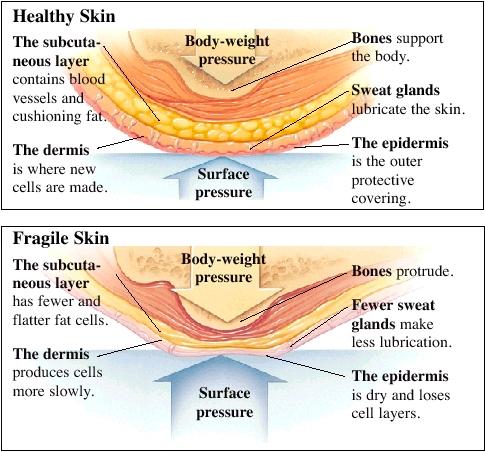Staff Ed: How Pressure Injuries Form
How Pressure Injuries Form
Even a healthy person can begin to develop pressure injuries in less than a day if left in the same position. It helps to know where and how pressure injuries develop and what you can do to prevent them.
Unrelieved pressure
People who can’t move for long periods of time are at risk for pressure injuries because oxygen and other nutrients can’t easily reach their cells. An immobile person with skin made fragile by age or disease is at even greater risk. This skin heals more slowly. Some persons have decreased sensation in these areas and don't feel the painful ulcerations developing.
Shear and friction
Two forces contribute to pressure injuries. Opposite, but parallel, sliding motions—like bone moving down and skin up—compress blood vessels. Surfaces rubbing (friction) can also cause skin to break down.
Put your finger on your shin and press down hard. Slide your finger up and down, allowing it to move roughly over your skin. As the skin slides over the bone it pulls and stretches. This is called shearing. If you continue sliding your finger up and down with enough pressure in both directions it can cause the skin to tear. This is especially true in an older or sick person whose skin isn't as tough as it used to be.
Moisture buildup
Skin overfilled with fluid is fragile. And certain kinds of fluid—sweat, urine, or feces—can provide a source for bacteria growth, delaying healing. Too much moisture carries another risk: it can increase friction.
Poor nutrition
Cells repair damage slowly if they do not get enough nutrition. This is especially true for a person who is sick or has an injury to the skin. When a person loses a lot of weight from not eating well and having poor nutrition, it makes the skin very thin and very weak and fragile.
Updated:
March 14, 2018
Sources:
Agency for Healthcar Research and Quality, Patient Safety and Quality, An Evidence Based Handbook for Nurses, 2008, Bluestein, D., Pressure Ulcers: Prevention, Evaluation, and Management, American Family Physician (2008); 78(10); pp, 1186-1194
Reviewed By:
Freeborn, Donna, PhD, CNM, FNP,Hurd, Robert, MD
